An Optimal Energy Management Method for the Multi-Energy System with Various Multi-Energy Applications
Abstract
1. Introduction
- The energy management of CCHP plant and P2H/G2P plant, and the demand side management of EV charging loads are modelled, and integrated in the energy management model of the MES as dispatch resources.
- Base on the developed model, a multi-objective optimal energy management problem is proposed to facilitate the cooperation of the ME applications, and simultaneously promote the RES utilization, and the overall economic and energy-saving performance of the MES.
2. Mathematical Modelling of ME Applications
2.1. Modelling of CCHP Plant
- Combined heat and power units (CHP) are the core of CCHP plants, which generates both heat and electricity. ηW and ηQ are used to describe the ratio of electric power output and heat power output to the fuel thermal energy input respectively.
- Combustion heat generators (CHG) are usually the thermal backup of the CHP. ηt is used to describe the ratio of heat power output to the fuel thermal energy input.
- Cooling power production side:
- Compression electric refrigeration generators (CERG) are widely used for producing cooling power, both for air conditioning and industrial purposes.
- Electrical heat pumps (EP) are a bimodal CCHP device which can produce heat and cooling power with electric power input.
- Water adsorption refrigeration generators (WARG) are heat-driven cooling power producers.
- Gas absorption refrigerator generators (GARC) are fuelled by natural gas, but are less widespread [27].
2.2. Modelling of P2H/G2P Facility
2.3. Demand Response of EV
3. Energy Management Framework
4. Simulation and Results
4.1. Case A
- The accommodating effects of the CCHP, P2H/G2P, and demand response of EVs are remarkable, the RES utilization rate raises from 2.6%, to 90.73%, 91.48%, and 91.77%. With all the three ME applications, even more RES could be adopted, a 93.14% RES utilization rate gain is achieved in Case 6.
- However, without a comprehensive energy management method, ME may not function in a coordinate way, as shown in Figure 5, thus fail to improve the utilization of the RES, and even worsen other performances of the MES.
4.2. Case B
- (1)
- Scenario 1: No ME applications are online;
- (2)
- Scenario 2: All the ME applications are online, while without energy management;
- (3)
- Scenario 3: All the ME applications are online with the proposed energy management method.
5. Conclusions
Author Contributions
Funding
Conflicts of Interest
Nomenclature
| A. CCHP plant | |
| Fi, Fo | Fuel thermal energy input/output (MW) |
| Wi, Wo | Electricity input/output (MW) |
| Qi, Qo | Heat input/output (MW) |
| Ri, Ro | Cooling power input/output (MW) |
| H | Efficiency matrix of CCHP plant |
| ηFF, ηFW, ηFQ, ηFR, ηWF, ηWW, ηWQ, ηWR, ηQF, ηQW, ηQQ, ηQR, ηRF, ηRW, ηRQ, ηRR | Entires in H (subscripts denote the type of energy outputs and energy inputs) |
| α | EDF array of CCHP plant |
| ηW, ηQ | Efficiency of CHP for electricity and heat production |
| ηt | Efficiency of CHG |
| COPQ, COPR | Coefficient of performance of EP for heat and cooling power production |
| μEP | The proportion of electricity input for heat production |
| COPWARG | Coefficient of performance of WARG |
| QDump | Dumped Heat of CCHP plant (MW) |
| B. P2H/G2P plant | |
| I | Operation mode indicator |
| PHdr | Output of P2H/G2P plant (MW) |
| ηG2P, ηP2H | Conversion efficiencies of G2P and P2H processes |
| , , , | Lower and upper output limits of P2H/G2P plants in G2P and P2H processes (MW) |
| Hsto | Storage level of P2H/G2P plant (MW·h) |
| , | Lower and upper storage limits (MW·h) |
| Hoth | Hydrogen power demand of other sectors (MW) |
| Upper limits of Hoth (MW) | |
| C. Demand response of EV | |
| Dev,i | Electricity consumption in period i (MW) |
| ρi | Electricity price in period i ($) |
| εii | Self-elasticity coefficient in period i |
| εij | Cross-elasticity coefficient between period i and period j |
| ΔDev,i, Δρi | Electricity consumption change (MW), price change ($) in period i |
| Dev,h, Dev,f, Dev,v | Electricity consumption during peak, flat and valley periods (MW) |
| ρh, ρf, ρv | Electricity price during peak, flat, and valley periods ($) |
| kh, bh, kf, bf, kv, bv | Factors used to describe the linearized relationships between electricity Consumption and price during peak, flat, and valley periods |
| ΩH, ΩF, ΩV | Peak, flat, and valley periods sets |
| ρTOU, ρ0 | Base electricity price array and TOU price ($) |
| D. Energy management model | |
| V | Decision variable vector |
| Fi | Objective function i |
| PG | Output array of generators (MW) |
| PHdr | Output array of P2H/G2P plants (MW) |
| ΩB, ΩG, ΩR | Buses, generators and RES set |
| ΩChr, ΩHdr, ΩCCHP | EV charging facilities, P2H/G2P and CCHP plants set |
| PG | Outputs of generators (MW) |
| PP2H/PG2P | Outputs of P2H/G2P plants in P2H/G2P mode (MW) |
| a, b, c | Consumption characteristics of generators |
| bP2H, cP2H, aG2P, bG2P, cG2P | Consumption characteristics of P2H/G2P plants |
| D | Electric load (MW) |
| PChr | EV charging load (MW) |
| Selling price of electricity ($) | |
| TOU EV charging price ($) | |
| Fuel price for electricity production ($) | |
| Fuel price for heat and cooling power production ($) | |
| PR | RES outputs (MW) |
| PR_max | Maximal RES outputs (MW) |
| WCCHP, QCCHP, RCCHP | Electricity, heat, and cooling output of CCHP plants (MW) |
| ηF | Fuel Thermal energy rate |
| PG, QG | Active and reactive power outputs of generators (MW) |
| PL, QL | Active and reactive demands (MW) |
| U, θ | Bus voltage magnitude and voltage angle |
| G, B | Conductance and reactance in admittance matrix |
| Sij | Apparent power between bus i and bus j (MVA) |
| , , , | Input and output limits of ME device x (MW) |
| , | ME input and ME demands of the CCHP plant m (MW) |
| ME exchange between CCHP plant m and external ME distribution networks (MW) | |
| , | Limits of EV charging price |
| Maximum EV charging load (MW) | |
References
- Mancarella, P.; Andersson, G.; Peças-Lopes, J.A.; Bell, K.R.W. Modelling of integrated multi-energy systems: Drivers, requirements, and opportunities. In Proceedings of the 2016 Power Systems Computation Conference (PSCC), Genoa, Italy, 20–24 June 2016; pp. 1–22. [Google Scholar]
- Bao, Z.; Zhou, Q.; Yang, Z.; Yang, Q.; Xu, L.; Wu, T. A Multi Time-Scale and Multi Energy-Type Coordinated Microgrid Scheduling Solution—Part I: Model and Methodology. IEEE Trans. Power Syst. 2015, 30, 2257–2266. [Google Scholar] [CrossRef]
- Clegg, S.; Mancarella, P. Integrated Electrical and Gas Network Flexibility Assessment in Low-Carbon Multi-Energy Systems. IEEE Trans. Sustain. Energy 2016, 7, 718–731. [Google Scholar] [CrossRef]
- Strbac, G. Integrating renewable energy to the grid optimising and securing the network: Facilitating cost effective integration of renewable energy in GB grid. In IET Seminar on Integrating Renewable Energy to the Grid: Optimising and Securing the Network; IET: London, UK, 2014; pp. 1–22. [Google Scholar]
- Olatomiwa, L.; Mekhilef, S.; Ismail, M.S.; Moghavvemi, M. Energy management strategies in hybrid renewable energy systems: A review. Renew. Sustain. Energy Rev. 2016, 62, 821–835. [Google Scholar] [CrossRef]
- Chen, Y.B.; Wang, Y.Z.; Ma, J. Multi-Objective Optimal Energy Management for the Integrated Electrical and Natural Gas Network with Combined Cooling, Heat and Power Plants. Energies 2018, 11, 734. [Google Scholar] [CrossRef]
- Mancarella, P.; Chicco, G. Integrated energy and ancillary services provision in multi-energy systems. In Proceedings of the 2013 IREP Symposium Bulk Power System Dynamics and Control—IX Optimization, Security and Control of the Emerging Power Grid, Rethymno, Greece, 25–30 August 2013; pp. 1–19. [Google Scholar]
- Zhang, R.; Jiang, T.; Li, G.; Chen, H.; Li, X.; Bai, L.; Cui, H. Day-ahead scheduling of multi-carrier energy systems with multi-type energy storages and wind power. CSEE J. Power Energy Syst. 2018, 4, 283–292. [Google Scholar] [CrossRef]
- Ivanova, P.; Sauhats, A.; Linkevics, O. District Heating Technologies: Is It Chance for CHP Plants in Variable and Competitive Operation Conditions? IEEE Trans. Ind. Appl. 2018. [Google Scholar] [CrossRef]
- Ban, M.F.; Yu, J.L.; Shahidehpour, M.; Yao, Y.Y. Integration of power-to-hydrogen in day-ahead security-constrained unit commitment with high wind penetration. J. Mod. Power Syst. Clean Energy 2017, 5, 337–349. [Google Scholar] [CrossRef]
- Shao, C.; Wang, X.; Wang, X.; Du, C.; Dang, C.; Liu, S. Cooperative Dispatch of Wind Generation and Electric Vehicles with Battery Storage Capacity Constraints in SCUC. IEEE Trans. Smart Grid 2014, 5, 2219–2226. [Google Scholar] [CrossRef]
- Siano, P. Demand response and smart grids—A survey. Renew. Sustain. Energy Rev. 2014, 30, 461–478. [Google Scholar] [CrossRef]
- Mancarella, P. From Cogeneration to Trigeneration: Energy Planning and Evaluation in a Competitive Market Framework. Ph.D. Thesis, Politecnico di Torino, Turin, Italy, 2006. [Google Scholar]
- Chicco, G.; Mancarella, P. Enhanced Energy Saving Performance in Composite Trigeneration Systems. In Proceedings of the 2007 IEEE Lausanne Power Tech, Lausanne, Switzerland, 1–5 July 2007; pp. 1423–1428. [Google Scholar]
- Schiebahn, S.; Grube, T.; Robinius, M.; Tietze, V.; Kumar, B.; Stolten, D. Power to gas: Technological overview, systems analysis and economic assessment for a case study in Germany. Int. J. Hydrog. Energy 2015, 40, 4285–4294. [Google Scholar] [CrossRef]
- Guandalini, G.; Campanari, S.; Romano, M.C. Comparison of gas turbines and power-to-gas plants for Improved Wind Park Energy dispatchability. In Proceedings of the ASME Turbo Expo 2014: Turbine Technical Conference and Exposition, Düsseldorf, Germany, 16–20 June 2014. [Google Scholar]
- Guandalini, G.; Campanari, S.; Romano, M.C. Power-to-gas plants and gas turbines for improved wind energy dispatchibility: Energy and economic assessment. Appl. Energy 2015, 147, 117–130. [Google Scholar] [CrossRef]
- Zhang, X.; Shahidehpour, M.; Alabdulwahab, A.; Abusorrah, A. Optimal Expansion Planning of Energy Hub with Multiple Energy Infrastructures. IEEE Trans. Smart Grid 2015, 6, 2302–2311. [Google Scholar] [CrossRef]
- Song, Y.H.; Yang, X.; Lu, Z.X. Integration of plug-in hybrid and electric vehicles: Experience from China. In Proceedings of the 2010 IEEE Power Engineering Society General Meeting, Providence, RI, USA, 25–29 July 2010; pp. 1–5. [Google Scholar]
- Ferdowsi, M. Vehicle Fleet as a distributed energy storage system for the power grid. In Proceedings of the 2009 IEEE Power Engineering Society General Meeting, Calgary, AB, Canada, 26–30 July 2009; pp. 1–2. [Google Scholar]
- De Forest, N.; Funk, J.; Lorimer, A.; Ur, B.; Sidhu, I.; Kaminsky, P.; Tenderich, B. Impact of Widespread Electric Vehicle Adoption on the Electrical Utility Business–Threats and Opportunities. University of California: Berkeley. Available online: http:// cet.berkeley.edu/dl/Utilities_Final_8-31-09.pdf (accessed on 28 September 2018).
- Yu, R.; Zhong, W.; Xie, S.; Yuen, C.; Gjessing, S.; Zhang, Y. Balancing Power Demand Through EV Mobility in Vehicle-to-Grid Mobile Energy Networks. IEEE Trans. Ind. Inform. 2016, 12, 79–90. [Google Scholar] [CrossRef]
- Sarker, M.R.; Ortega-Vazquez, M.A.; Kirschen, D.S. Optimal Coordination and Scheduling of Demand Response via Monetary Incentives. IEEE Trans. Smart Grid 2015, 6, 1341–1352. [Google Scholar] [CrossRef]
- Xu, Z.W.; Hu, Z.C.; Song, Y.H.; Zhang, H.C.; Chen, X.S. Coordinated Charging Strategy for PEV Charging Stations Based on Dynamic Time-of-use Tariffs. Proc. CSEE 2014, 34, 3638–3646. [Google Scholar]
- Chen, C.Y.; Hu, B.; Xie, K.G.; Wan, L.Y.; Xiang, B. A Peak-Valley TOU Price Model Considering Power System Reliability and Power Purchase Risk. Power Syst. Technol. 2014, 38, 2141–2148. [Google Scholar]
- Deb, K.; Pratap, A.; Agarwal, S.; Meyarivan, T. A fast and elitist multi-objective genetic algorithm: NSGA-II. IEEE Trans. Evol. Comput. 2002, 6, 182–197. [Google Scholar] [CrossRef]
- Harvey, L.D.D. A Handbook on Low-Energy Buildings and District-Energy Systems: Fundamentals, Techniques and Examples; Routledge: London, UK, 2012; ISBN 978-184407-243-9. [Google Scholar]
- Kirschen, D.S.; Strbac, G.; Cumperayot, P.; Mendes, D.D. Factoring the elasticity of demand in electricity prices. IEEE Trans. Power Syst. 2000, 15, 612–617. [Google Scholar] [CrossRef]
- Safdarian, A.; Fotuhi-Firuzabad, M.; Lehtonen, M. A Medium-Term Decision Model for DisCos: Forward Contracting and TOU Pricing. IEEE Trans. Power Syst. 2015, 30, 1143–1154. [Google Scholar] [CrossRef]
- Wood, A.J.; Wollenberg, B.F.; Wiley, J. Power Generation, Operation, and Control; Wiley-Interscience: Hoboken, NJ, USA, 1996. [Google Scholar]

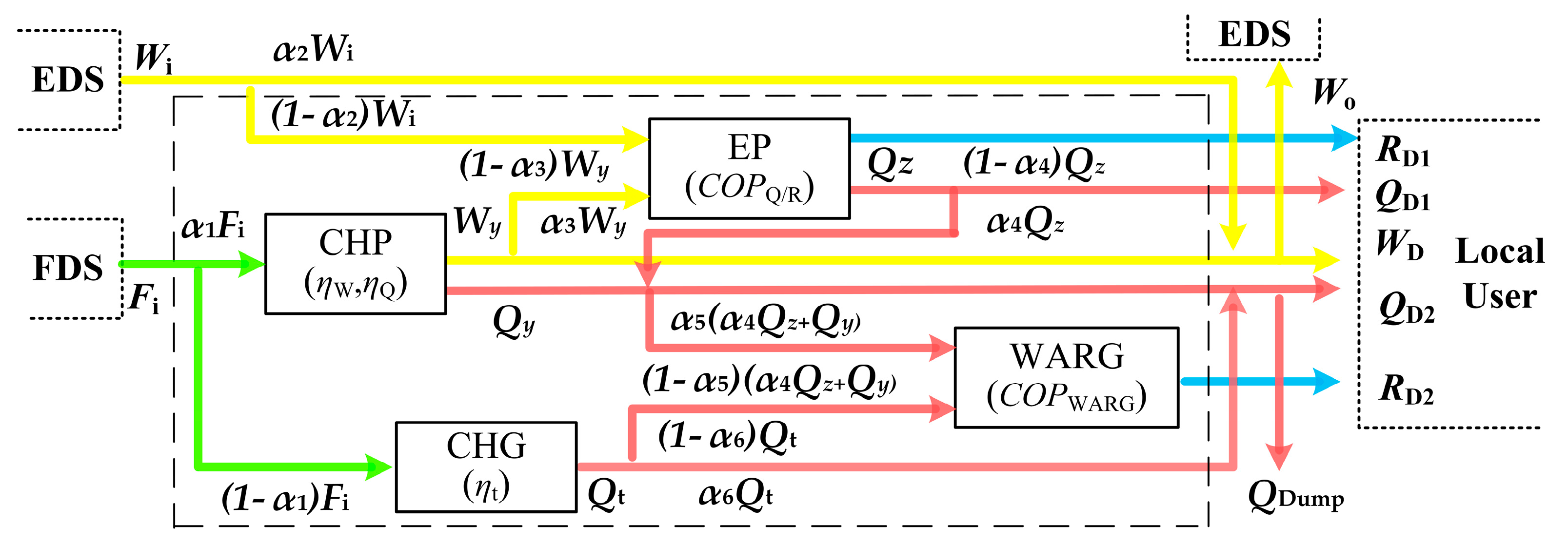
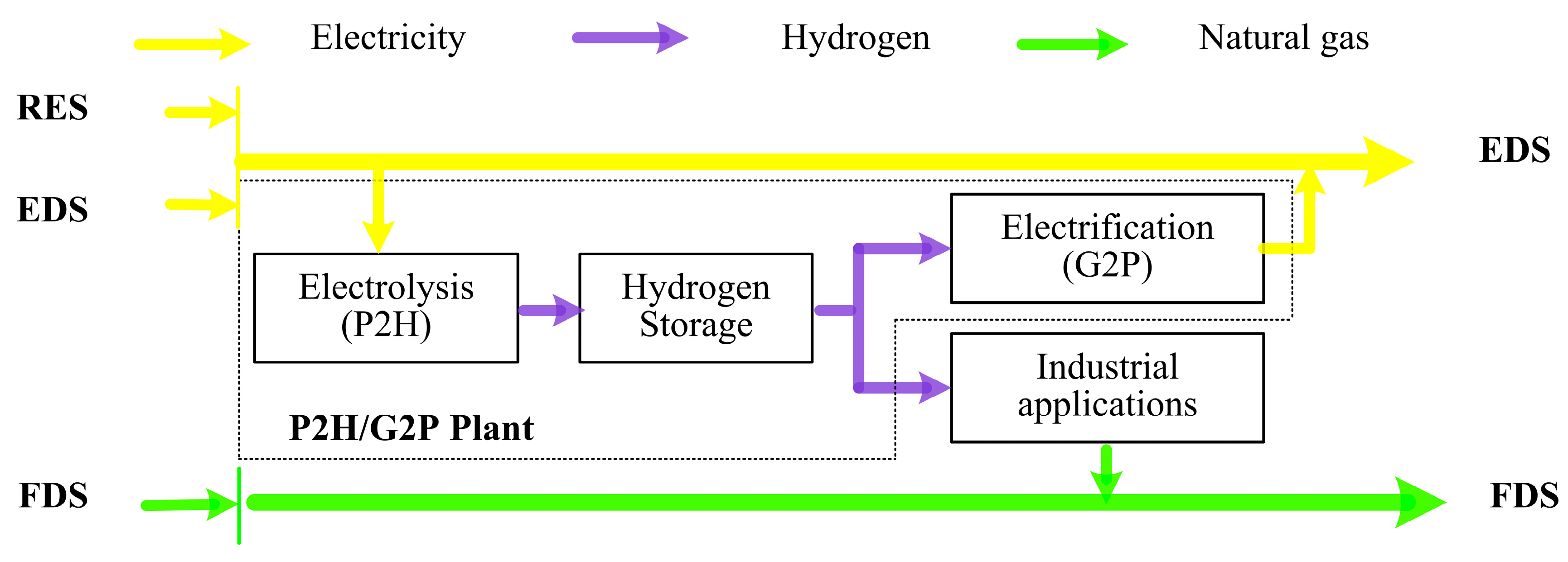


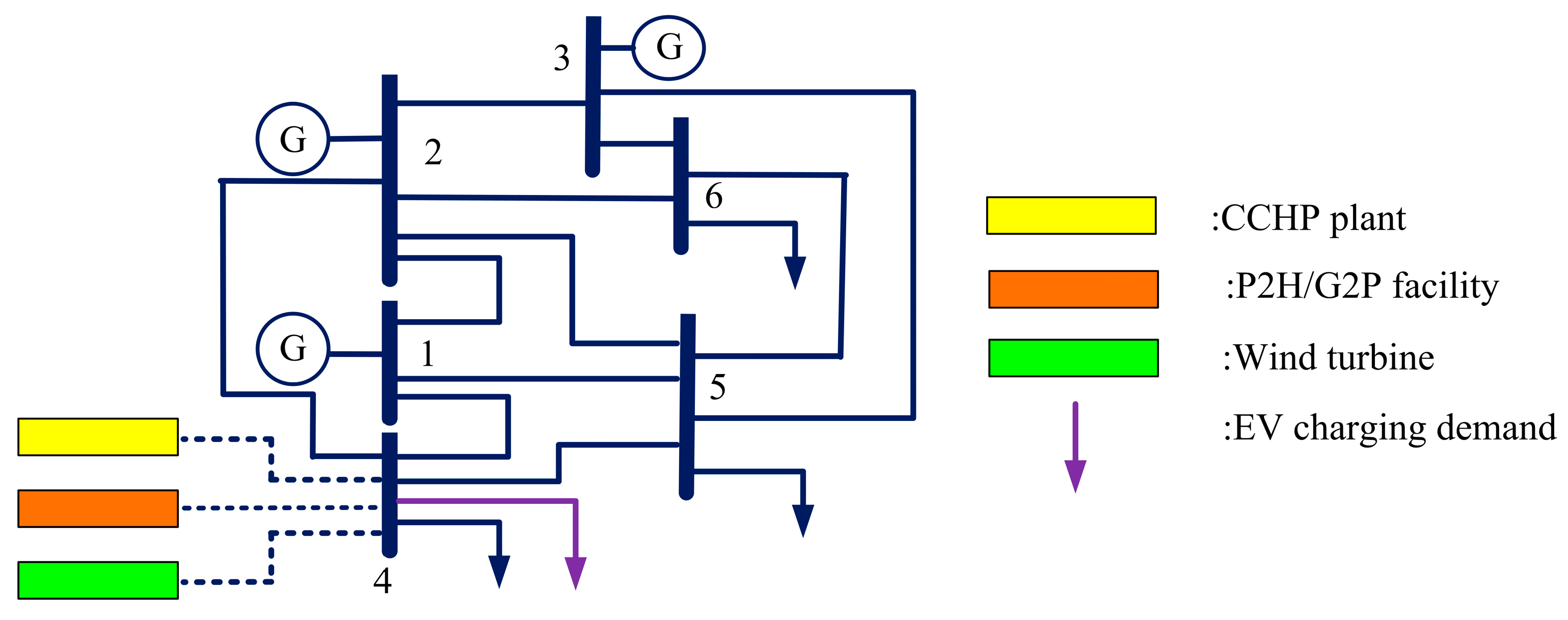
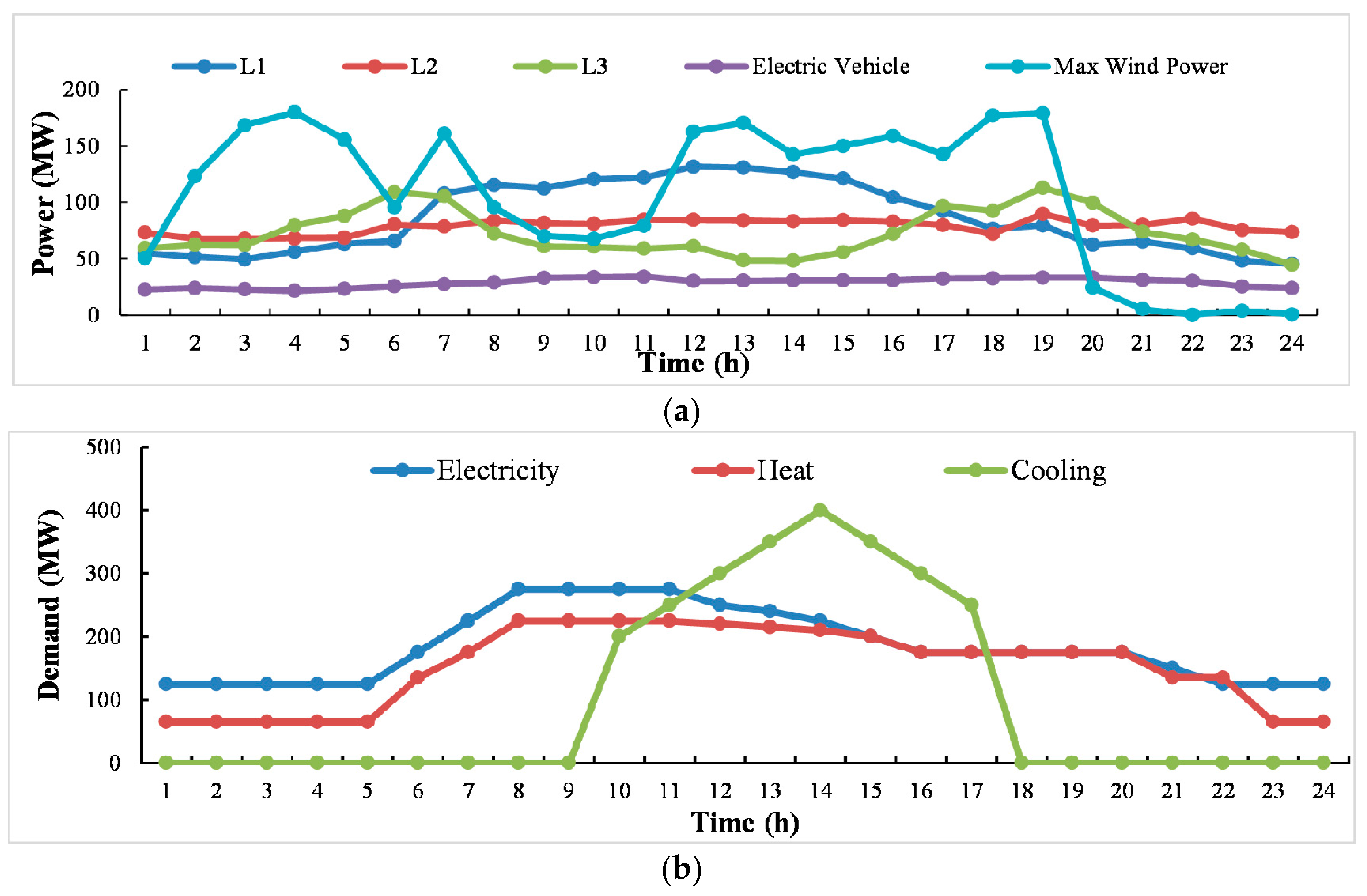
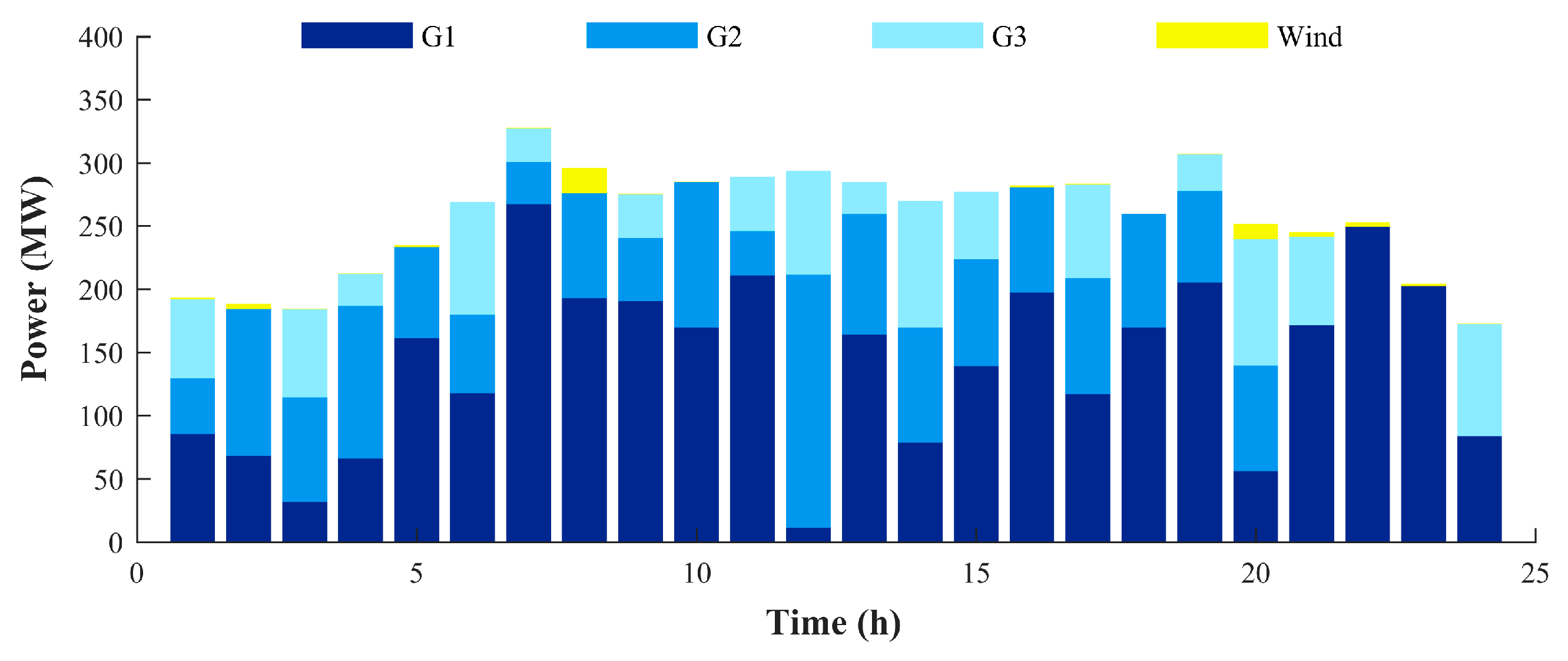
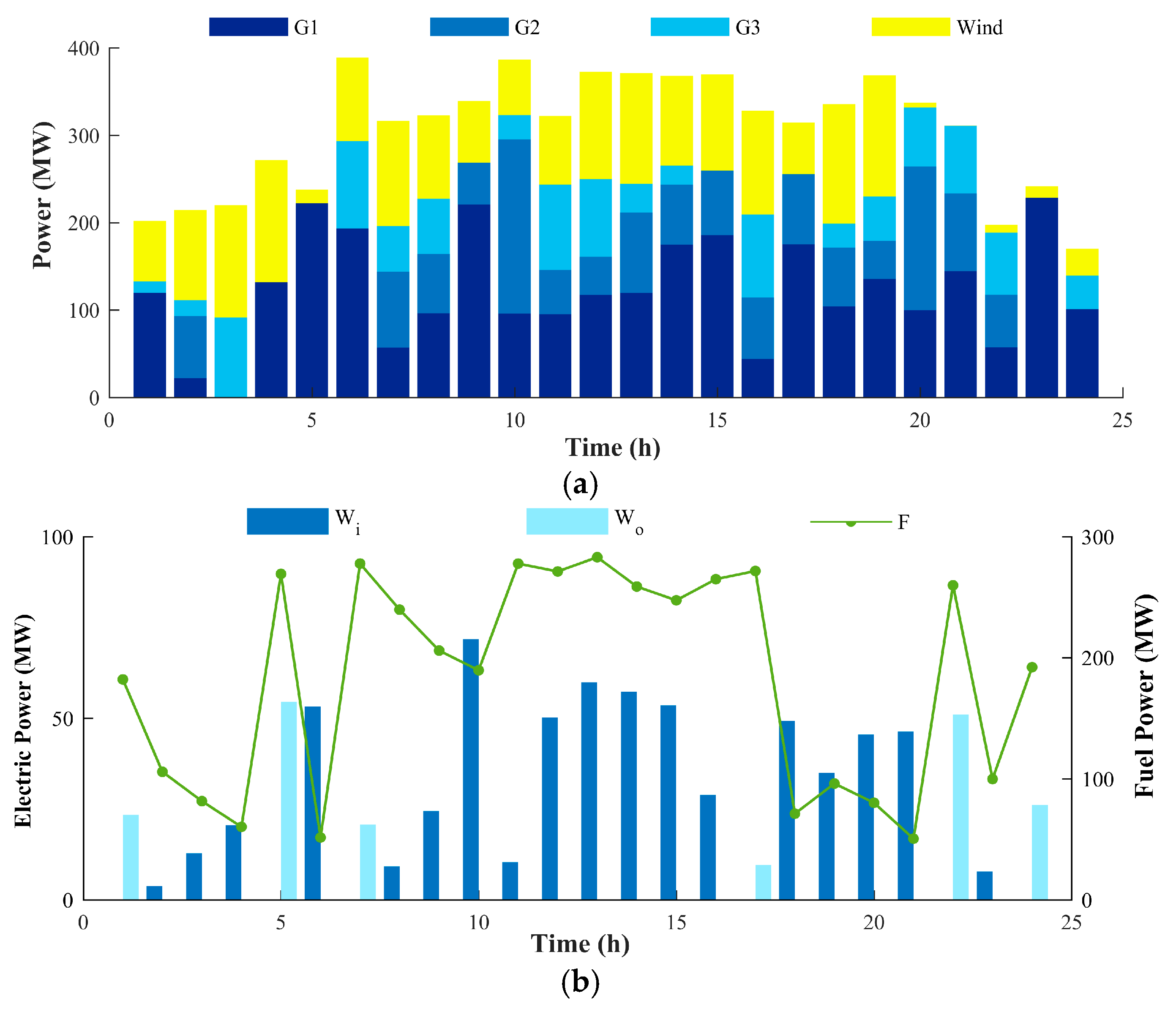

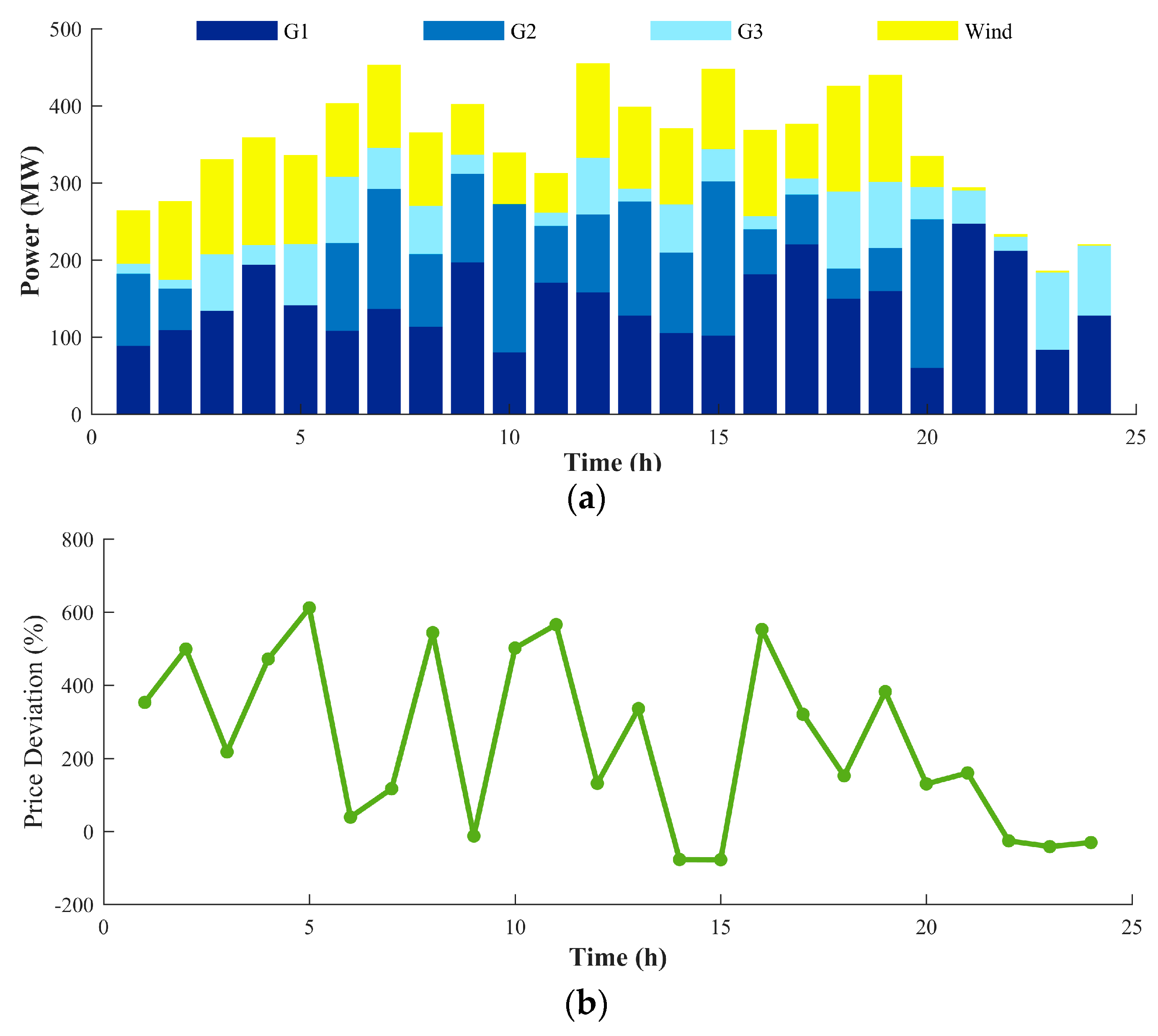
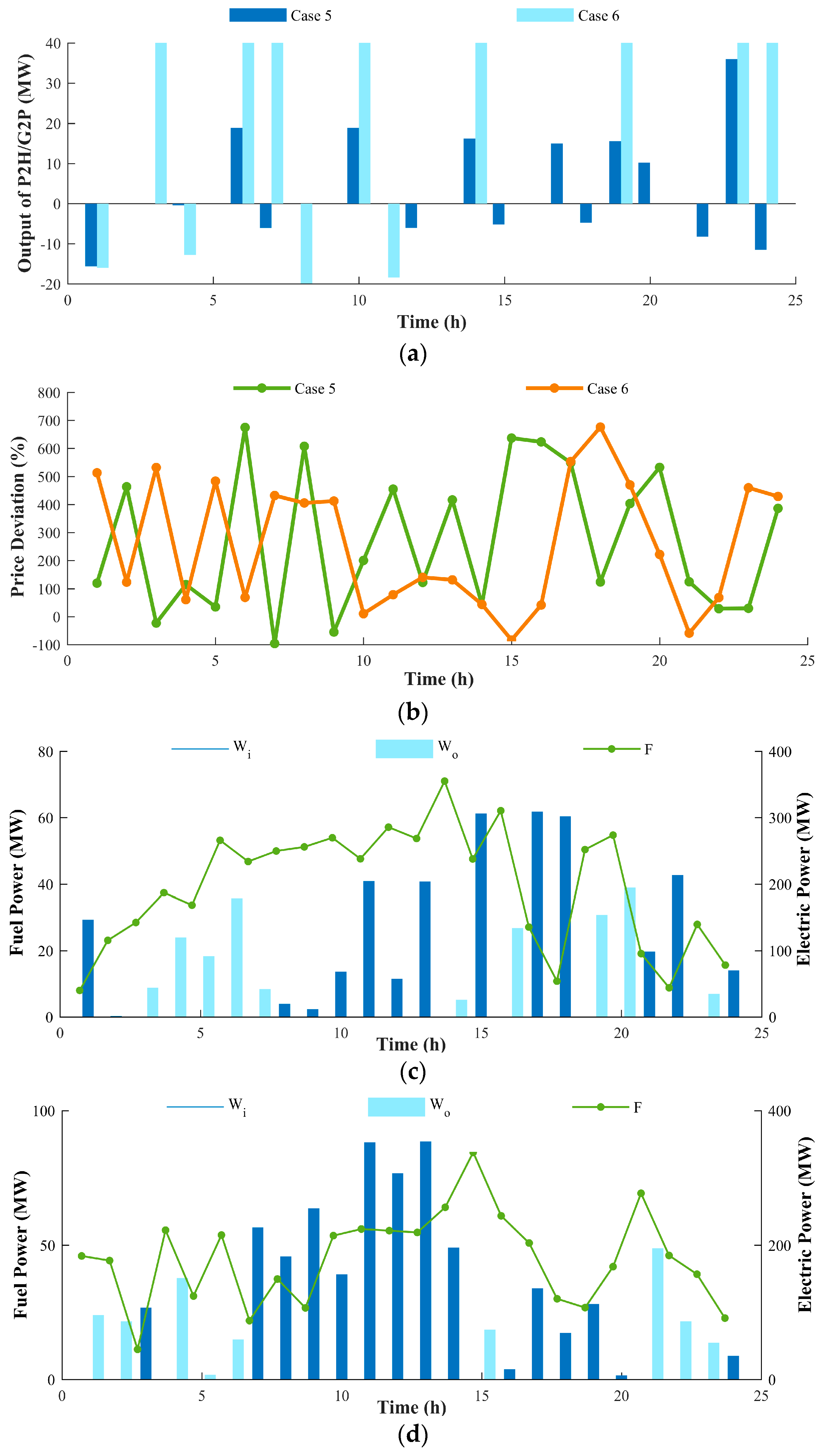
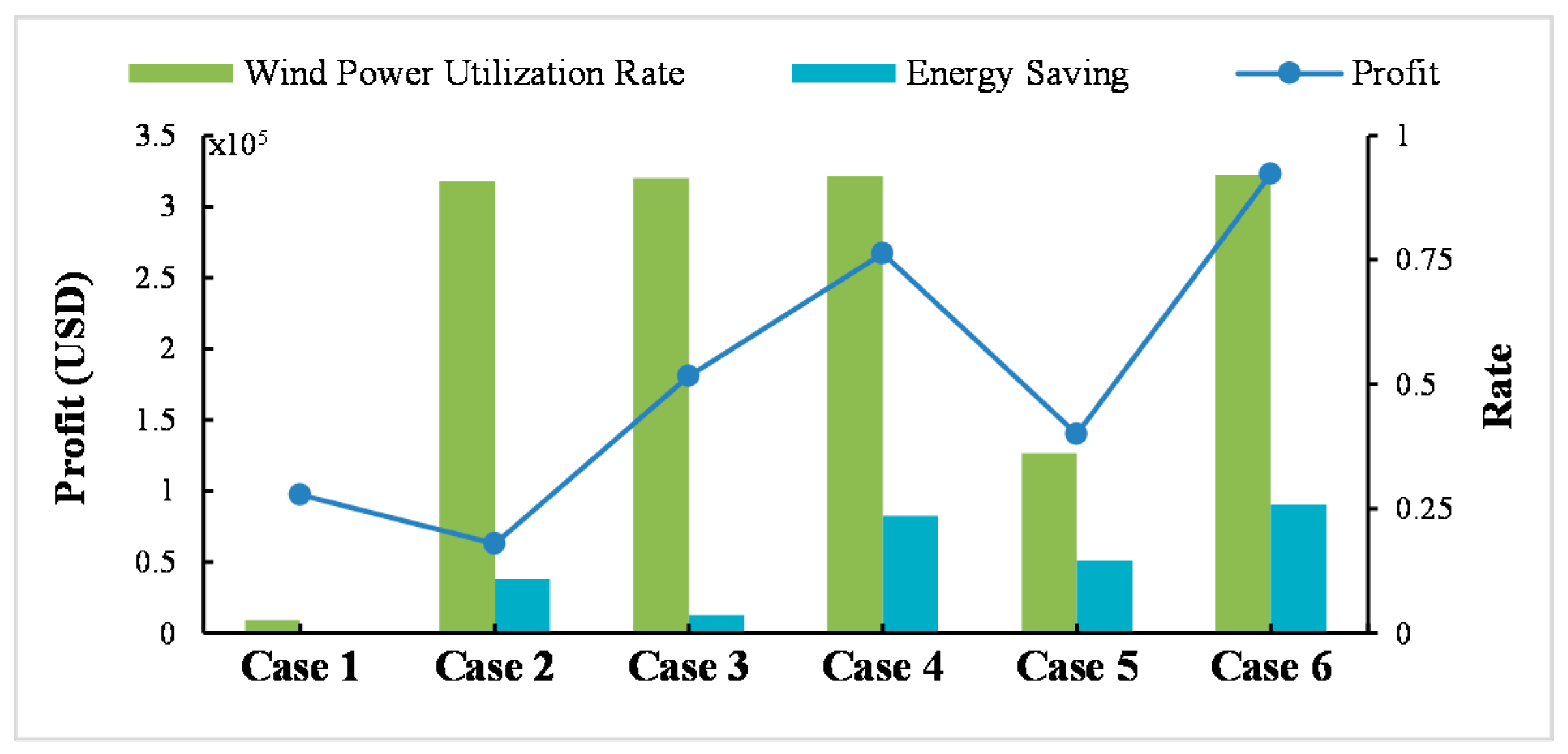
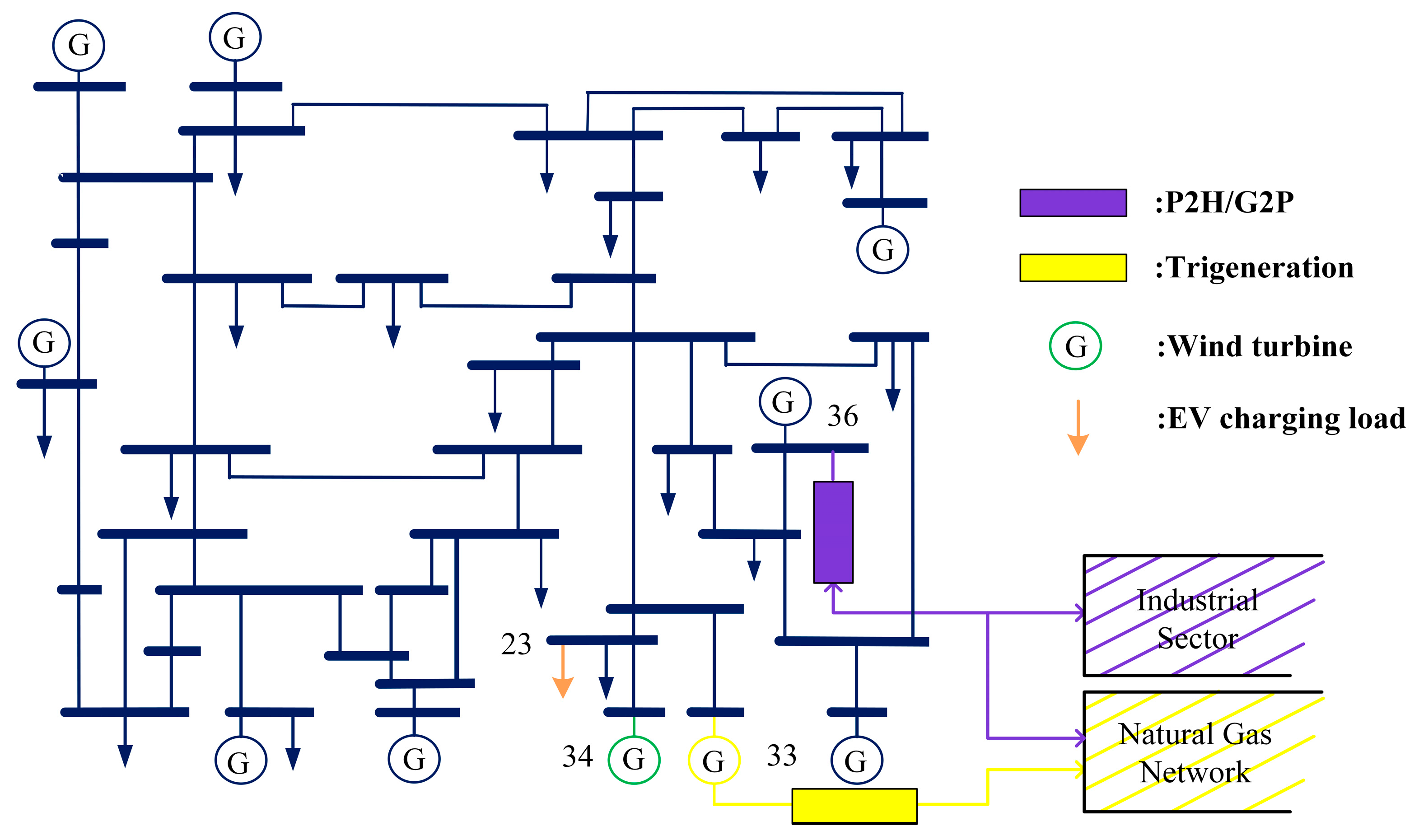
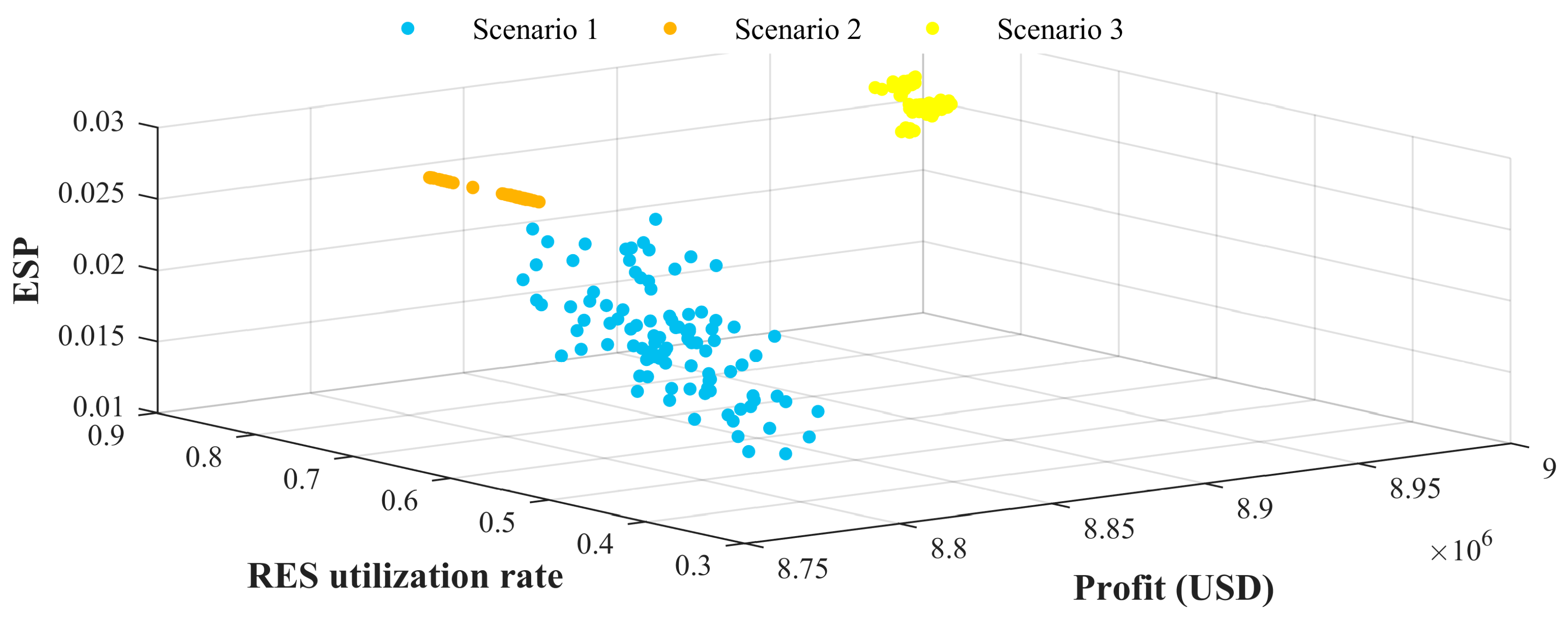
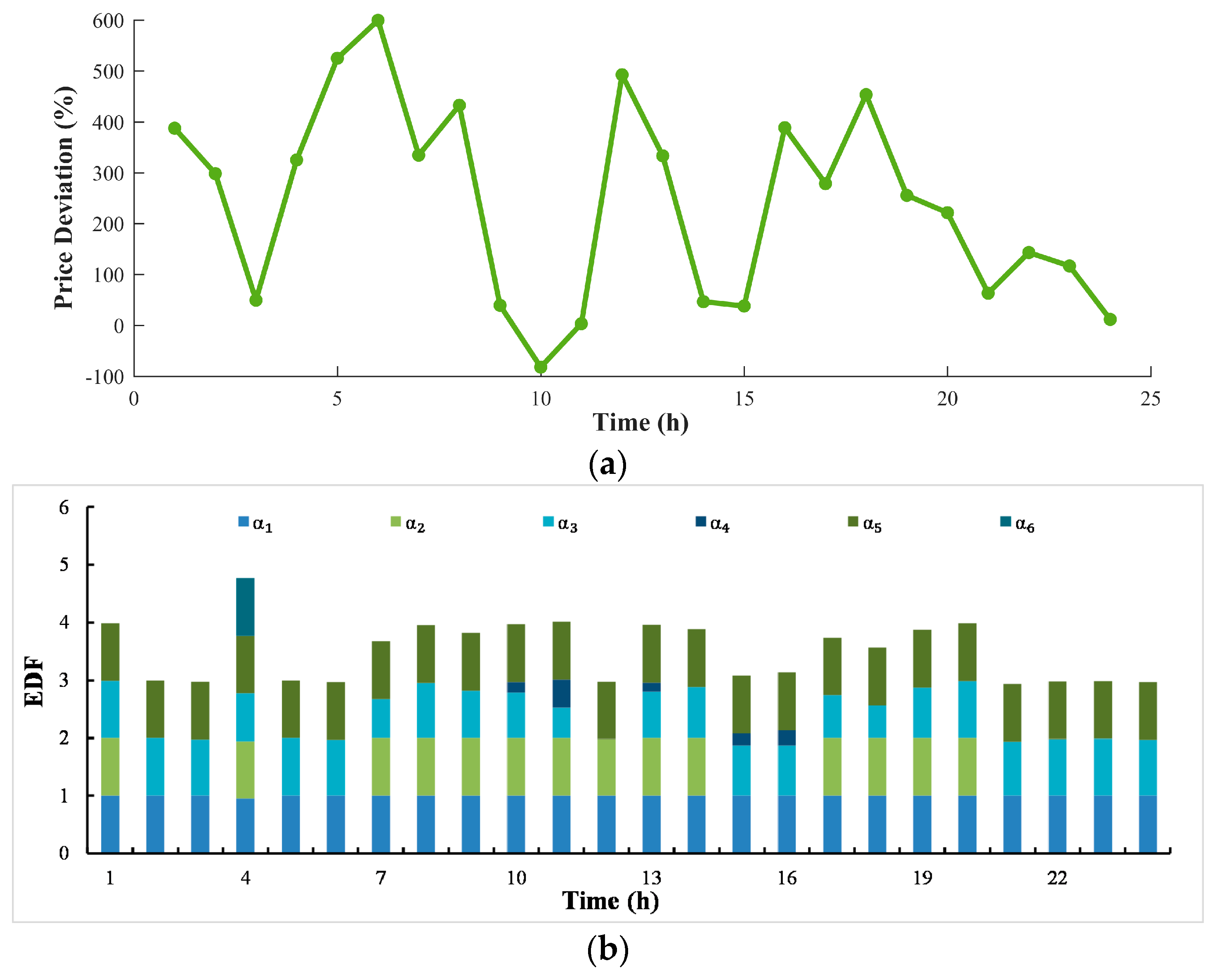

| Unit | a (MBtu/MW2h) | b (MBtu/MWh) | c (MBtu) |
|---|---|---|---|
| G1 | 0.0004 | 13.5 | 176.9 |
| G2 | 0.001 | 32.6 | 129.9 |
| G3 | 0.006 | 17.6 | 137.4 |
| P2H | - | 12.5 | 141 |
| G2P | 0.0065 | 19.6 | 141.4 |
| Unit | Pmax (MW) | Pmin (MW) | γ (CNY/MBtu) | Ton (h) | Toff (h) |
|---|---|---|---|---|---|
| G1 | 700 | 100 | 8.1049 | 1 | 1 |
| G2 | 250 | 30 | 8.0997 | 2 | 3 |
| G3 | 200 | 10 | 8.1003 | 1 | 1 |
| P2H | 40 | 10 | 0.065 | 1 | 1 |
| G2P | 20 | 10 | 8.125 | 1 | 1 |
| ME Device | Efficiency | Capacity |
|---|---|---|
| CHP | ηW = 36% | 300 MW |
| ηQ = 43% | ||
| CHG | = 90% | 650 MW |
| EHP | COP = 3.5 | 150 MW |
| WARG | COPWARG = 0.65 | 800 MW |
| Case Num. | Wind Power | CCHP | P2H/G2P | Demand Response of EVs |
|---|---|---|---|---|
| 1 | √ | × | × | × |
| 2 | √ | √ | × | × |
| 3 | √ | × | √ | × |
| 4 | √ | × | × | √ |
| 5&6 | √ | √ | √ | √ |
© 2018 by the authors. Licensee MDPI, Basel, Switzerland. This article is an open access article distributed under the terms and conditions of the Creative Commons Attribution (CC BY) license (http://creativecommons.org/licenses/by/4.0/).
Share and Cite
Wang, Y.; Zhang, K.; Zheng, C.; Chen, H. An Optimal Energy Management Method for the Multi-Energy System with Various Multi-Energy Applications. Appl. Sci. 2018, 8, 2273. https://doi.org/10.3390/app8112273
Wang Y, Zhang K, Zheng C, Chen H. An Optimal Energy Management Method for the Multi-Energy System with Various Multi-Energy Applications. Applied Sciences. 2018; 8(11):2273. https://doi.org/10.3390/app8112273
Chicago/Turabian StyleWang, Yangzi, Kai Zhang, Chun Zheng, and Huiyuan Chen. 2018. "An Optimal Energy Management Method for the Multi-Energy System with Various Multi-Energy Applications" Applied Sciences 8, no. 11: 2273. https://doi.org/10.3390/app8112273
APA StyleWang, Y., Zhang, K., Zheng, C., & Chen, H. (2018). An Optimal Energy Management Method for the Multi-Energy System with Various Multi-Energy Applications. Applied Sciences, 8(11), 2273. https://doi.org/10.3390/app8112273




